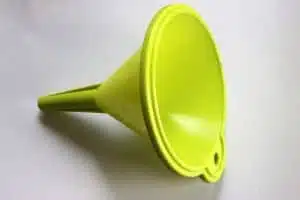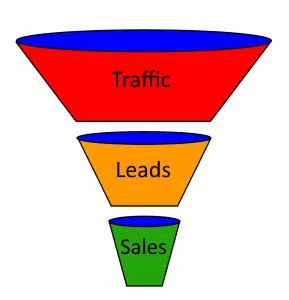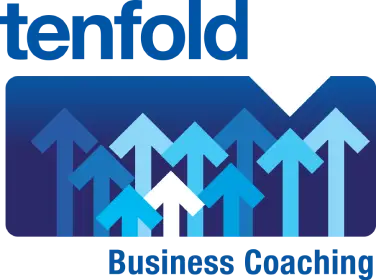Funnels are so last year… but what are they? And why your business needs a flywheel instead.
 It’s official: flywheels are the new funnels. HubSpot says.
It’s official: flywheels are the new funnels. HubSpot says.
Don’t worry if you’re only understanding every other word of that statement – you’re not alone. Many marketers have been remarkably slow to fully embrace ‘funnel’ vision. It’s not surprising, therefore, that most business owners still view their content strategy purely as a way to improve SEO for their website.
Now HubSpot has gone and shape-shifted their funnel conversion model into a spinning wheel. It’s hard to wrap your head around until you understand why. Then it will all make sense. Promise.
But first, let’s take a step back. To understand where this is all heading, you’ll need to understand where we’re coming from. So, let’s brush up on the basics…
If you have a business, you have a ‘funnel’
Whether you know it or not, if you own a business, then you are already the proud owner of a funnel. It provides an easy way to visualise the structure of your sales process and the way potential customers make their journey towards buying your product or service.
A funnel consists of three main parts:

The ‘wide bit at the top’ = Traffic (getting to know you)
At the top you have a wide opening representing the general ‘traffic’ that pours into (or is attracted towards) your funnel.
At this stage, this group knows that your business exists and may even have some understanding that you offer a solution to a problem that they have. How did this happen?
Hey everybody – look over here!
You’ve done something to attract them to your business (also known as ‘lead generation’). This may have included:
- Advertising – eg TV, Radio, Facebook ads
- Directory listings – Google My Business, True Local, Yelp, Sensis etc
- Search engine optimisation (SEO) – to ensure you’re at least within the first page of results for your search terms on Google
- Referrals – word-of-mouth and online reviews
- Content marketing – free useful information in the form of blogs, social media posts, videos or podcasts etc
- Lead magnets – promoting an e-book, guide, video, discount offer, free trial etc that features on your website (or that they must contact you to collect)
A purchase at this stage is unusual. Unless there is an emergency involved – a burst pipe tends to whittle down the purchase decision process to who is available… NOW!
Most often the goal is here is turning brand awareness into engagement.
You can’t win ‘em all
You will inevitably lose some of this general ‘traffic’ as people opt out – either due to lack of interest or an inability to buy. This explains why the funnel shape has always seemed so relevant – it physically represents the way that the population of your funnel gets smaller as general ‘traffic’ are converted into ‘leads’.
Which brings us to…
The ‘middle bit’ = Leads (starting to like and trust you)
At this stage, potential customers begin to engage and interact with your brand by signing up for your mailing list, newsletter, lead magnet, offer etc. Basically, they are putting their hand up and saying, “I want to know more”.
The price of admission? Contact details – most often a name and an email address (or sometimes a phone number). Now you have an opportunity to nurture these leads.
The Rule of Seven
Conventional wisdom says that most customers will need to encounter your brand at least seven times before they will take action towards making a purchase. Therefore, your focus should be on building a relationship and keeping the momentum going so that leads stick around and flow into the next part of the funnel.
Making your case
At this stage, you will need to educate your potential customers about how your offering aligns with their needs. Help them understand why they should choose you as the solution to their problems.
This can be done through:
- Sales pages/product or service pages – landing pages on your website that outline all the key information a customer would want or need to know
- Case Studies and Testimonials – this kind of ‘social proof’ increases customer confidence. They might feature on your website, as part of email campaigns or as content in your newsletter or blogs
- FAQs – A comprehensive ‘frequently asked questions’ page can go a long way towards resolving some of the common concerns that a potential customer might have
- Sales calls – ‘in person’ interactions are still an important part of the process, particularly for service-based businesses, purchases that require a larger investment and B2B contracts etc. Jumping on a call with a prospect allows you to gather important information and build rapport
- Email sequences – a series of (often automated) emails designed to ‘unpack’ and address concerns that a customer may have at certain predictable points in their decision-making process. The important part is that each email must ask them to ‘do something’ (known as a ‘call to action’). It may be something simple such as ‘read this blog’ or something with some urgency such as ‘spots for our free consults book up fast – book today to avoid disappointment’
- Blogs, newsletters, social media, videos – consistently showing up with valuable content helps establish authority and demonstrate expertise. Regular interactions also increase the odds of your name appearing in front of a lead at at the right time – just as they are ready to move into the purchasing stage
A note on tracking
This mid-section of the funnel is often neglected in favour of the top (generating more leads) and bottom (closing deals) sections. That’s a shame because customer behaviour at this stage offers some of the most useful insights. Once you are talking directly to your leads you can
- control the messages they receive about your business
- track their response
Tracking is one of the biggest advantages of online marketing. You can now know for sure how many people are visiting your website, signing up for your lead magnets, opening your emails, reading your blog, liking your social media posts. Is the general response a little chilly? Not to worry! You can use that information to adjust your marketing efforts and increase your conversion rates.
For more on this check out our blog on A/B testing.
Last (but not least) – the “bottom” of the funnel = Sales (time to buy!)
This is what we’ve all been waiting for – the stage where all your hard work pays off and the (admittedly smaller number of) remaining leads convert into customers. The ideal scenario sees a happy customer at the bottom refer traffic into the top of the funnel and the whole process starts all over again.
Sounds ok… what’s wrong with all of that?
It seems like there’s a lot about the funnel to recommend it. It certainly appears to reflect the way an ideal customer takes an ideal stroll through our sales process and ideally makes a purchase at the end.
Ideal. Maybe that’s the issue?
What about those rogue leads that ‘tunnel into the funnel’ at various stages? How do we account for the way customers are increasingly able (and keen) to conduct their own research? What about the easy access they have to independent online reviews of products and services?
Customers don’t walk through your sales process in a straight line.
Yep, we’ve been looking at this all wrong. We’ve been trying to jam customers into a funnel, when we should have been following them around as they explore our businesses, ready to remove any roadblocks that might slow them down.
Hence the flywheel.
Next time
…So what exactly is a flywheel? What makes them superior to a funnel? How can you transform your customers into your biggest brand advocates? We’ll answer these questions (and more) next week. Same time. Same place. Bring coffee.
Image by mufinn via Flickr



